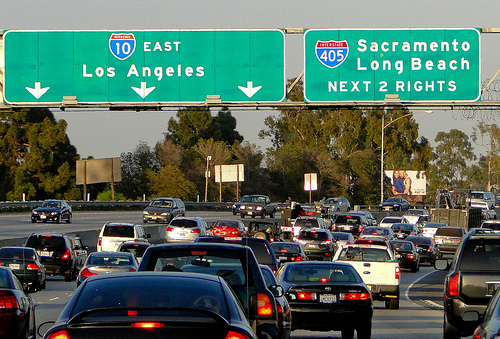 This week, Affiliated Computer Services, Inc. (ACS) — which was acquired by Xerox (NYSE: XRX) in February 2010 — announced that it’s building a new, electronic toll system on the two busiest highways in Los Angeles, to allow all single car drivers, even those in diesel guzzling Hummers, to shift into carpool lanes for a fee.
This week, Affiliated Computer Services, Inc. (ACS) — which was acquired by Xerox (NYSE: XRX) in February 2010 — announced that it’s building a new, electronic toll system on the two busiest highways in Los Angeles, to allow all single car drivers, even those in diesel guzzling Hummers, to shift into carpool lanes for a fee.
When average traffic levels in a carpool lane rise overall, so will the fee. The company and city plan to calibrate the systems to keep traffic at a steady 45 miles per hour in the carpool lane (at least). Once equipped with the new toll system, the carpool lanes along Interstate 10 and Interstate 110 will be called ExpressLanes, instead.
Los Angeles and Xerox are building this project with the idea of reducing highway congestion overall, according to a press statement from ACS and reports by Green.Autoblog.com.
Is the death of the carpool lane as we know it environmentally sound, though?
The faster, wide open appeal of a carpool lane is supposed to motivate Los Angelenos to roll with their homeys, instead of Swingers style; remember that distinctly not-green-scene where Vince Vaughn and his friends drive individually but together to party after party? At least, a carpool lane’s supposed to encourage drivers to buy clean vehicles.
The Department of Motor Vehicles and state law in California allows vehicles with a qualifying “clean alternative fuel vehicle sticker” to drive in high occupancy vehicle (HOV) lanes.

Ken Philmus, senior vice president and managing director of ACS Transportation Systems and Services, believes that a pay-to-switch-lanes system is a win for the environment, of course. Here’s why, he explained:
“When people are stuck in traffic, watching the other lane, they might be encouraged to get into a carpool, later. Only 10 percent of vehicles [in Los Angeles] are multi-occupant, generally. So, there’s under-utilized capacity in [high occupancy vehicle, or HOV] lanes.
With this system, as the HOV lane gets more congested, the toll to shift over goes up, which should result in fewer [single car drivers] going in, and a free flow that’s maintained. It should not damage the occupancy of the lane. But it should maintain or improve environmentally positive aspects of the lane, by getting people out of stop and go traffic. That’s where the air quality situation becomes worse, usuall.”
ACS and Xerox are not charged with studying things like improvements in air quality, or reduction in diesel consumption in Los Angeles, resulting from this project in any official capacity, Philmus said. That job will be up to the likes of the Federal Highway Administration, local air quality management offices and departments of transportation instead.
To participate, Los Angeles drivers will need to sign up for a FasTrak toll account, and install a small transponder in their vehicles. They will be asked to set a switch on the transponder to indicate whether they’re driving solo and the system should charge them; or if they’re part of a carpool and can drive for free in the ExpressLanes. Sensors installed along the interstate will calculate the dynamically priced tolls and deduct the proper amount from a driver’s prepaid account, automatically.
The ExpressLanes Project in Los Angeles is projected to open to traffic in late 2012. Similar systems have been installed in Miami, where they’re known as HOT lanes (high occupancy toll lanes), and are averaging around $3.50 or $4.00 a toll during rush hour, and are about 16 miles per hour faster than regular, free lanes according to reports in the Miami Herald.
Image: Traffic on Interstate 10, under creative commons license via Florian